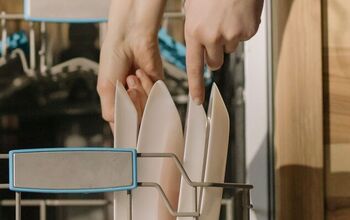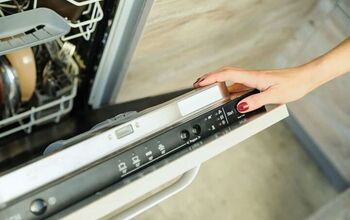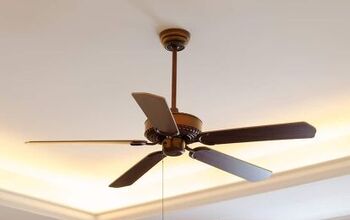Does Your Dishwasher Stop Mid-Cycle? (Possible Causes & Fixes)

If it seems like your dishwasher’s running time is a lot shorter than normal, it may actually be shorter. There are times where a dishwasher may stop mid-cycle, failing to complete its normal cleaning cycle for one reason or another.
But why does the dishwasher stop mid-cycle? Well, there are a few common reasons. The most common causes for that mid-cycle stop are the door latch, a blown fuse or thermal fuse, the pump and motor, and the electronic control board. You will have to troubleshoot the issue to find out the cause behind the issue.
If you have a Bosch dishwasher that is not starting at all, check out Bosch Dishwasher Is Not Starting And A Red Light Is Flashing?
Do You Need Appliance Repair Services?
Get free, zero-commitment quotes from pro contractors near you.

Why is My Dishwasher Stopping Mid-Cycle?
When your dishwasher runs but seemingly stops mid-cycle, there are a few common culprits behind the issue. The real reason that the dishwasher stops is that a safety mechanism has been triggered during the cycle.
When one of a few different components goes bad or stops working properly, it triggers that safety mechanism. This is to ensure that the dishwasher doesn’t continuously run and potentially flood or do other damage.
Fuse or Thermal Fuse
Perhaps the most likely reason that your dishwasher will stop mid-cycle is due to a blown fuse. In this instance, the dishwasher will stop mid-cycle and then won’t start up again. There are a few places to start.
- Indicator lights. Should there be indicator lights on the front of your dishwasher, that means you are still getting power. When you don’t see any indicator lights, that means there is no power going into the appliance. In that instance, you would want to check for a blown fuse or tripped breaker. The latter is particularly easy to reset and get your dishwasher going once again.
- Thermal fuse. On the other hand, you may be looking at a thermal fuse being blown out. The thermal fuse acts as a safety measure. Its role is to watch the temperature within the unit and, when it gets too hot, to cut off power. When it detects a temperature too high, the fuse then trips and cuts off the power. If the thermal fuse is bad, then it will continue to trip or may not activate at all, keeping the dishwasher from working properly.
- Check the fuse box. While the thermal fuse may not necessarily be at fault in this instance, the fuse box is a good place to start. If you are sure that the breaker hasn’t been tripped, start by checking out the fuse box to look for blown fuses. This is typically the most likely cause and can also be one of the quickest fixes, too.
Door Latch
Though it is seemingly inconsequential, the door latch is one of the most important safety mechanisms in the dishwasher. When the latch is not properly seated, you cannot run the dishwasher.
The latch prevents unwanted cycles from taking place. Think about it like this: you don’t want the dishwasher running until you set the cycle. Otherwise, there is a risk of water leaking out and onto your floor, creating a huge mess.
- Lack of engagement. More often than not, there is not anything actually wrong with the latch itself. It may just be that you have not properly secured the latch before trying to start the dishwasher. Make sure that you hear a clicking noise to ensure that the latch has seated properly.
- Faulty switch. If you have tried multiple times to seat the latch and still get the same result, the switch could be at fault. Even when you shut the door tightly, the latch might not properly engage. Test it out a few times and consider replacing if you still have the same issue.
- Latch assembly. When you are certain that the latch is at fault, consider replacing the entire latch assembly. It is a cheap, easy fix and you can rest assured that your new latch assembly will perform its function the right way. You can either consult the manual or do a cursory Google search to see the model number of your dishwasher and the corresponding latch assembly that it needs.
Pump and Motor
For the dishwasher to run at all, the unit needs not only water but also the proper water pressure to perform. If you have checked out the door latch and gone through the other possible faults, circle back around to the faucet. Turn on your faucet and ensure that your home is still getting water at all.
- Water connection. If you have tested the faucet and gotten the typical result, then there is an issue with water getting into the dishwasher. A lost water connection is not necessarily uncommon but it doesn’t really happen all the time, either.
- Motor. When the motor fails, it can’t produce the necessary water pressure to produce a cycle. The machine can kick on, but when it realizes it can’t get adequate water pressure, stops mid-cycle.
- Pump. Likewise, if the pump is bad, it can’t provide the unit with the water that it needs. You might hear a louder than normal noise or even leaking in some instances when the pump is bad. The dishwasher may still start, but more often than not, you will be looking at a totally non-functional dishwasher instead.
Troubleshoot the issue to locate the source of the problem. If you are something of an amateur, it may be a better bet to call in a professional. They have more experience at troubleshooting the issue and locating the cause of the problem. That means time – and frustration – saved in the long run.
Electronic Control Board
If you are unfamiliar with the electronic control board, there is one simple way to think of it. The electronic control board acts as the “brain” of the entire unit. They are designed to last the entire life of the dishwasher, but that does not mean that they can’t go bad from time to time.
Troubleshooting the electronic control board can be difficult. Because it controls so many different functions within the dishwasher, it may be hard to pinpoint the trouble spot. The board can go faulty over time, leading it to shut down mid-cycle.
When the board is at fault, there is a good chance that other problems arise as well. A good indication that the board is bad is if you not only have a mid-cycle shutoff, but other problems manifesting as well.
Control Panel
This is not the same as the control board. The control panel is the set of buttons on the front/top of your dishwasher. Also known as the control console, it can become damaged or loose over time, preventing it from working properly.
- Stuck buttons. There are a few ways to troubleshoot the issue. The first is to check to ensure that the buttons have not become stuck in place. When buttons are stuck, the dishwasher may become unresponsive altogether.
- Flashing lights. If you should notice a flashing light on your control panel, that is as much an indication that something is wrong as anything else. A light that is constantly flashing indicates that a button is stuck or that there is a malfunction somewhere.
- Replacing the unit. If you feel that the control panel is at fault, you will need to purchase a new unit and replace the old one. Getting the right control panel can be a tricky endeavor, so consult your dishwasher’s manual before ordering new parts. You may also want to consider consulting the manufacturer before replacing the part. They may be able to walk you through troubleshooting the problem without the need to replace the panel entirely.
- Call a professional. Getting nowhere with the manufacturer? Try bringing in a professional technician instead. They have the necessary experience to troubleshoot the issue and implement the correct fix sooner rather than later.
Do You Need Appliance Repair Services?
Get free, zero-commitment quotes from pro contractors near you.

Fan Assembly
This one can be a bit tricky. There is the chance that your dishwasher actually completed the wash cycle but finished a little faster than it normally does. That typically indicates that the drying cycle has been skipped and points to a fan issue.
- Fan. When you notice that your dishes are still dripping wet even after completing its cycle, the fan is the first place to look. The dishwasher may recognize that the fan has gone bad and will skip the drying cycle entirely.
- High-limit thermostat. On the same hand, if you notice that the dry cycle starts but cuts off, the fan could still be working. When that is the case, then there are other components that may be at fault instead. The high-limit thermostat is responsible for keeping the dishwasher from getting too hot. When it malfunctions, the heating element can turn off prematurely.
When you notice that there are colder temperatures during the wash cycle, break out the multimeter. Test out the high-limit thermostat to ensure that it is working properly. Most of the time, dishes won’t come out quite as clean when the heating element goes out during the cycle.
More Related Guides

Ryan Womeldorf has more than a decade of experience writing. He loves to blog about construction, plumbing, and other home topics. Ryan also loves hockey and a lifelong Buffalo sports fan.
More by Ryan Womeldorf






















![10 Most Dangerous Neighborhoods in Baltimore [Updated]](https://cdn-fastly.upgradedhome.com/media/2023/07/31/9075655/10-most-dangerous-neighborhoods-in-baltimore-updated.jpg?size=350x220)




